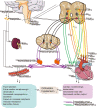The Pathogenesis and Treatment of Cardiovascular Autonomic Dysfunction in Parkinson's Disease: What We Know and Where to Go
- PMID: 34631214
- PMCID: PMC8460297
- DOI: 10.14336/AD.2021.0214
The Pathogenesis and Treatment of Cardiovascular Autonomic Dysfunction in Parkinson's Disease: What We Know and Where to Go
Abstract
Cardiovascular autonomic dysfunctions (CAD) are prevalent in Parkinson's disease (PD). It contributes to the development of cognitive dysfunction, falls and even mortality. Significant progress has been achieved in the last decade. However, the underlying mechanisms and effective treatments for CAD have not been established yet. This review aims to help clinicians to better understand the pathogenesis and therapeutic strategies. The literatures about CAD in patients with PD were reviewed. References for this review were identified by searches of PubMed between 1972 and March 2021, with the search term "cardiovascular autonomic dysfunctions, postural hypotension, orthostatic hypotension (OH), supine hypertension (SH), postprandial hypotension, and nondipping". The pathogenesis, including the neurogenic and non-neurogenic mechanisms, and the current pharmaceutical and non-pharmaceutical treatment for CAD, were analyzed. CAD mainly includes four aspects, which are OH, SH, postprandial hypotension and nondipping, among them, OH is the main component. Both non-neurogenic and neurogenic mechanisms are involved in CAD. Failure of the baroreflex circulate, which includes the lesions at the afferent, efferent or central components, is an important pathogenesis of CAD. Both non-pharmacological and pharmacological treatment alleviate CAD-related symptoms by acting on the baroreflex reflex circulate. However, pharmacological strategy has the limitation of failing to enhance baroreflex sensitivity and life quality. Novel OH treatment drugs, such as pyridostigmine and atomoxetine, can effectively improve OH-related symptoms via enhancing residual sympathetic tone, without adverse reactions of supine hypertension. Baroreflex impairment is a crucial pathological mechanism associated with CAD in PD. Currently, non-pharmacological strategy was the preferred option for its advantage of enhancing baroreflex sensitivity. Pharmacological treatment is a second-line option. Therefore, to find drugs that can enhance baroreflex sensitivity, especially via acting on its central components, is urgently needed in the scientific research and clinical practice.
Keywords: Parkinson’s disease; cardiovascular autonomic dysfunction; orthostatic hypotension; postprandial hypotension; supine hypertension.
copyright: © 2021 Zhu et al.
Conflict of interest statement
Competing interests The authors report no competing interests.
Figures

References
-
- Ziemssen T, Reichmann H (2010). Cardiovascular autonomic dysfunction in Parkinson’s disease. J Neurol Sci, 289:74-80. - PubMed
Publication types
LinkOut - more resources
Full Text Sources
Miscellaneous
